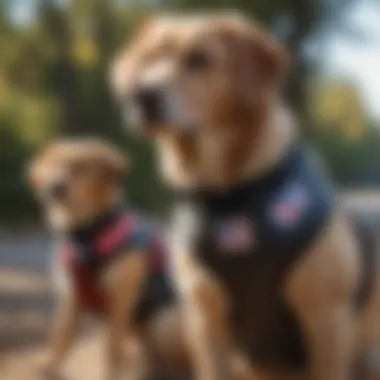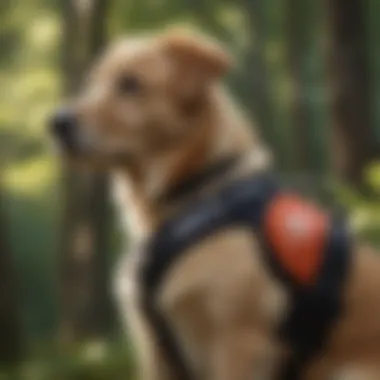Understanding the Color Significance of Service Dog Vests


Intro
The impact of service dogs goes far beyond their training; their appearance also plays a crucial role in how they are perceived and treated in various settings. The colors of service dog vests are not just aesthetic choices. They serve specific purposes, conveying information about the animal as well as its handler. This significance can be felt in the dynamics of everyday interactions. Understanding this topic can illuminate various complexities surrounding service dogs, particularly in terms of their public recognition.
In various regions and organizations, the colors of these vests can differ, leading to a bit of confusion amongst the public. This article will unravel these differences and offer insights into the legal implications governing the use of service dogs. We will also venture into the psychology of color, exploring how different hues can evoke distinct emotions or perceptions in observers.
As we navigate through this discussion, our aim is to highlight best practices for service dog vest usage. By connecting each thread, we will paint a clearer picture of how service dogs and their vibrant vests operate within society.
Intro to Service Dogs
Understanding the integral role that service dogs play in society is essential, particularly when one examines the nuances surrounding their identification. Service dogs are not merely pets; they are trained companions that provide vital assistance to individuals with disabilities. This article delves into the importance of these animals, particularly highlighting how their vests serve as visual markers of their roles and rights.
The presence of a service dog can significantly enhance the quality of life for its handler by providing support that often goes beyond physical assistance, extending into emotional and psychological realms. This discussions will cover the specifications of service dog vests and the colors associated with them, allowing for a comprehensive appreciation of how these garments facilitate interaction between dog and handler while navigating public spaces.
Definition and Purpose
Service dogs are trained to perform tasks that directly mitigate their owner's disability. This training differs significantly from that of therapy or emotional support animals, giving service dogs a distinct position within the scope of canine assistance. The purpose of a service dog is to provide more than just companionship; it's about enabling independence and improving the handler's accessibility to the wider world.
Consider, for example, a person with mobility challenges who relies on their service dog to retrieve objects, open doors, or even assist in maneuvering through environments that would otherwise pose difficulty. The vest worn by the service dog is a signal to the public that this canine is on duty, serving a crucial function that should be respected.
Roles of Service Dogs
Service dogs fulfill many vital roles, and understanding these is key to grasping their significance beyond simple companionship. Each task is tailored specifically to meet the needs of their handlers. Here are a few of the core roles:
- Mobility Assistance: Some service dogs are specially trained to help individuals with physical disabilities by performing tasks that involve balance stabilization or navigation aid.
- Medical Alert: Certain breeds are trained to detect medical conditions such as seizures or low blood sugar. Their ability to alert their handler can be lifesaving.
- Psychiatric Support: Some service dogs are trained to assist individuals with PTSD, anxiety, or depression. They provide comfort and can create a sense of security for their handlers.
- Hearing Dogs: For members of the deaf or hard-of-hearing community, these dogs are trained to alert their owners to sounds in their environment, such as alarms or doorbells.
In unraveling the complexities of service dogs, this article will ultimately clarify how these versatile animals not only serve individual handlers but also pave the way for greater public awareness and understanding of their importance.
Understanding Service Dog Vests
When one looks at service dog vests, it’s not just about appearance; it’s about identity and functionality. These vests serve a pivotal role in society, marking the distinction between a pet and a working companion. The conversation surrounding them extends beyond style; it encompasses recognition, rights, and responsibilities. Understanding service dog vests involves delving into their necessity and implications.
Importance of Identification
A service dog vest is often the first thing people notice. This visual cue signals to the public that the dog is not a standard pet and plays an essential role in assisting a person with disabilities. The vest’s purpose is twofold: it promotes awareness of the dog's function and fosters a sense of respect for the team working in public spaces.
Familiarity fosters better interaction. When individuals recognize service dogs by their vests, it reduces the likelihood of distractions or unintentional interference. After all, these canines perform tasks that help their handlers navigate daily life. A vest can help prevent being pestered by curious strangers or other dogs, allowing the service dog to focus on its duties.
There’s also a more subtle aspect to the identification concept. The color and design specifics of a vest can convey information about the type of assistance offered—whether for mobility support, emotional support, or various conditions like autism or PTSD. This can often imbue handlers with a sense of empowerment; they can navigate their environment without constant explanation of their circumstances.


Legal Rights and Regulations
Venturing into the legal framework surrounding service dog vests reveals a landscape filled with nuances and variances. Laws like the Americans with Disabilities Act (ADA) establish that service dogs are defined as those that perform tasks for individuals with disabilities. However, these regulations can differ by region, leading to a patchwork of rules regarding vest usage and rights.
Handlers of service dogs need to be aware of their legal rights, including their ability to access public spaces. The ADA affirms that service dogs are permitted where the general public is allowed. Yet, it’s crucial for handlers to know that they are not required to provide documentation for their dogs or wear a vest; however, doing so can smooth interactions.
In some regions, there are additional laws that pertain to the identification of service dogs, along with penalties for misrepresenting a pet as a service animal. Understanding these regulations is fundamental not just for the handler's peace of mind, but also for maintaining balance in public awareness and empathy. Misrepresentation can hinder the efforts of those genuinely relying on these indispensable companions.
"A service dog vest is not merely fabric—it’s a lifeline for countless individuals and their companions, straddling the line between personal support and public recognition."
In summary, understanding service dog vests is not merely an academic exercise; it’s about appreciating their practical significance in society. It underscores the real-world implications of color, design, and legal guidelines—all converging to shape the experience of service dog handlers and their essential partners.
Color Significance in Service Dog Vests
The color of service dog vests plays a critical role in various aspects of their functionality and societal perception. It is not merely a question of aesthetics but a complex interplay of communication and identification. The hues chosen for these vests serve as visual cues, helping the public quickly recognize a service dog and its vital role. Through this section, we will unpack how certain colors resonate with people, what associations they carry, and how these colors can vary in meaning across different contexts.
The overall importance of color in service dog vests cannot be overstated. When a service dog is outfitted in a distinctive vest, it signals to bystanders that the animal is not an ordinary pet. The chosen color can enhance the identification of the dog, making it clear that the dog is tasked with specific responsibilities. This visual distinction is essential in busy environments where immediate recognition is critical.
Common Colors and Their Meanings
Several colors are frequently used in service dog vests, each carrying its own set of associations and meanings. Here are some common colors and what they generally signify:
- Yellow: Often associated with guiding and alerting, yellow is a bright, eye-catching color that emphasizes the active role of the service dog. It helps in building a positive perception.
- Blue: A calming color, blue is often linked to emotional support and stabilization. Many organizations choose blue vests to illustrate the supportive nature of these animals.
- Red: This vibrant color typically implies a warning. When a service dog wears a red vest, it can signify urgency, alerting the public that the dog is performing crucial tasks.
- Green: Usually associated with relaxation and healing, green emphasizes the calming presence of therapy dogs or emotional support animals.
- Black: While neutral, black can convey seriousness and professionalism. Service dogs wearing black vests often indicate they are highly trained and ready for specific tasks.
These color meanings, while typical, may not be universally understood. Therefore, education about these colors is essential, especially for those unfamiliar with the roles of service animals.
Variations Based on Region and Organization
The selection of vest colors can also vary significantly based on geographic region, as well as organizational guidelines. Different countries or even regions within a country might have specific color-coding systems. For example:
- In the United States, many organizations adhere to common colors such as blue or red, yet some regions might promote different standards.
- In the United Kingdom, the guide dog community may prefer bright yellow or white, signifying particular types of assistance.
Furthermore, organizations such as Service Dogs International might have their own color preferences that reflect the specific traits of the dogs they train. Here's a short list summarizing how organizations approach color usage:
- Service Dog Organizations: Often use blue or orange as part of their brand identity.
- Emotional Support Animal Groups: They may employ softer colors to convey a nurturing approach, like lavender or light blue.
Ultimately, the color of a service dog vest can carry layers of meaning and significance that go beyond the surface. Understanding these variations can help the community better appreciate the work these animals do and promote public awareness about service dogs, encouraging a more supportive and informed dialogue.
Psychology of Color in Service Dog Vests


Understanding the psychology of color within the context of service dog vests holds significant weight. It’s not just about aesthetics; the colors serve as a communication tool that bridges gaps between service dogs and the general public. Different hues evoke varied reactions, potentially impacting how onlookers perceive the dog and its handler. The choice of color can help signal a dog’s role, facilitate understanding, and foster an environment where people can identify the service being provided.
When considering vest colors, it can be helpful to explore both universal and cultural perceptions. Colors like blue are often associated with trust and reliability, while bright shades like yellow attract attention and are commonly linked with guide dogs. As colors convey messages subtly but powerfully, they come loaded with expectations. Understanding this framework can assist handlers in optimizing their vest color choices to enhance recognition of their service animals.
Impact of Color on Human Perception
Colors can spark immediate reactions and emotional responses. Recent studies delve into how humans attribute meanings based on color alone. For instance, red may signal urgency, while softer colors like pastels tend to evoke calmness.
- Attention-Grabbing: Bright colors make service dogs stand out, ensuring they are easily identifiable in crowded spaces. This can be essential when quick recognition is crucial for the dog's function.
- Emotional Cues: Color choices might influence how people feel about the dog. For example, warm colors such as orange and yellow can evoke friendliness, encouraging people to interact positively with the service animal and, by extension, its handler.
- Cultural Context: Different cultures often have distinct interpretations of colors. An example can be the color purple, which in Western cultures may convey nobility or spirituality, but in other societies might have entirely different connotations. This makes it cricial for handlers to be familiar with their audience’s background.
"The right color can mean the difference between being acknowledged as a servant of assistance or just a pet on a leash."
Choosing the Right Color for the Dog's Role
Selecting a vest color that aligns with a service dog's specific role can amplify its efficacy in the public sphere. It’s valuable to approach this decision with clear intent:
- Guide Dogs: These dogs often wear yellow or blue vests. The bright colors help alert pedestrians and encourage them to give way for the animal and its handler, ensuring their safety in busy environments.
- Therapy Dogs: More subdued tones, like green or tan, can suggest warmth and approachability. These colors tend to be less intimidating and more inviting, creating a sense of comfort for those in stressful situations.
- Medical Alert Dogs: These animals might benefit from bright orange or red vests, signaling urgency and attention. The choice of colors reflects a need for immediate acknowledgment from bystanders regarding the special needs of the handler.
Best Practices for Service Dog Vest Usage
When it comes to service dogs, the vest swears a vital role—serving not just as a tool for identification, but as a representation of the important work these animals do. Understanding the best practices surrounding the vests can help handlers make informed choices that enhance the dog's effectiveness in their duties.
Selecting the Appropriate Vest
Choosing the right vest for a service dog is not just a matter of aesthetics. It requires careful consideration of material, fit, and functionality. Here’s what to keep in mind:
- Fit and Comfort: Ensuring the vest fits well is paramount. A poorly fitting vest can hinder a dog's movement and cause discomfort. This can lead to distractions during tasks, which can potentially compromise the safety and efficacy of the service dog. Thus, measuring the dog's chest, neck, and back is indispensable.
- Material Quality: The fabric should be durable and breathable. For example, a vest made of heavy materials can overheat the dog, while a lightweight one may not withstand rigorous daily activities. It’s wise to opt for vests with adjustable straps, which provide flexibility to accommodate growing dogs or allow for easy removal.
- Visual Identification Features: The vest should ideally feature bold, clear text or symbols indicating the dog’s service role. This not only helps in identifying them in public spaces but also reinforces the importance of not interrupting their tasks.
Each service task may demand different specifications—for instance, a guide dog might need a more structured vest compared to a therapy dog. Therefore, it's crucial to tailor the vest selection to the dog’s primary function.
Maintaining the Vest and Ensuring Comfort
A vest is an extension of the service dog’s identity, and like any piece of equipment, it requires regular maintenance. Here are some practices to consider:
- Regular Inspections: Check the vest frequently for wear and tear. Ensure the straps are intact, the material is free from damage, and all identification patches are securely fastened. Addressing minor issues before they escalate is key to ensuring longevity.
- Cleaning Routine: Given that service dogs often operate in various environments, keeping the vest clean is essential. Most vests can tolerate machine washing, but it’s advisable to always check the manufacturer's instructions. A dirty vest can become a source of irritation for the dog, potentially affecting its performance.
- Temperature Considerations: Observe how different weather conditions can affect the comfort of the vest. In colder climates, adding layers underneath might be beneficial; conversely, in the heat, opting for a vest designed for ventilation can help maintain the dog’s comfort.
"Choosing the right vest not just enhances the dog’s appearance, it also reinforces the human-dog bond through the provision of comfort and utility."


- Reassess Fit Periodically: Since dogs grow and change over time, it’s good practice to reassess the fit of the vest regularly. What was snug a few months ago might be loose today, or vice versa. A well-fitted vest promotes comfort, allowing the dog to focus fully on its tasks.
In summary, adhering to best practices for service dog vests—not just in selection but also in maintenance—ensures the dog can perform its duties efficiently and comfortably. A mindful approach pays dividends in fostering trust and reliability between the service dog and its handler.
Public Responses to Service Dog Vests
Understanding public responses to service dog vests is crucial for fostering a more accommodating environment for both service dogs and their handlers. The colors and designs of these vests carry more than mere aesthetics; they have profound implications for public perception and understanding of the roles service dogs play. When people notice a service dog wearing a vest, they often make quick judgments based on its color and appearance, which can lead to both positive and negative interactions.
The benefits of educating the public about the significance of service dog vest colors are multifaceted. First, it helps in demystifying the presence of service dogs in various settings, such as restaurants, stores, and parks. Additionally, a well-informed public can lead to fewer confrontations or misunderstandings regarding the rights of service dog teams. The visibility of service dog vests also plays a vital role in allies—even strangers—recognizing and respecting the needs of both the dog and the handler.
Interpreting Vest Colors in Social Contexts
The color of a service dog vest does not merely serve as decoration; it often communicates specific messages regarding the dog's function and the handler's needs. For instance, a bright yellow vest might suggest that the dog is trained in mobility assistance, while a blue vest could be associated with therapy or emotional support. The nuances in these colors can greatly affect how the public interacts with service dog teams.
It's worth noting that these assumptions can sometimes lead to misconceptions. For example, someone might approach a service dog with a distinctive color, thinking it is there to assist them in a manner that may not align with the dog's actual role. This can lead to confusion and frustration for the handler who may feel the need to explain their dog's work repeatedly.
"Understanding the context of a service dog's vest color helps foster a more empathetic society, where individuals become more aware of the unseen challenges faced by service dog teams."
Ultimately, educating the public on interpreting vest colors helps reduce stigma and encourages respectful interactions. This includes refraining from petting the dog or engaging in conversation unless permitted by the handler, thereby enabling the service dog to focus on their job without distractions.
Challenges Faced by Service Dog Handlers
Service dog handlers face a myriad of challenges, especially concerning their vests and the perceptions surrounding them. One of the most significant hurdles comes from lack of understanding and misconceptions held by the public. This lack of knowledge can result in unwarranted questioning of the legitimacy of a service dog’s role. Handlers frequently encounter situations where they are forced to validate their service animal, an experience that can feel invasive and discouraging.
Additionally, handlers often find themselves on the receiving end of unwanted attention. The visibility of service dog vests can invite inquiries that, while well-intentioned, can disrupt the flow of daily activities. Moreover, they sometimes experience outright denial of access to establishments, despite having legal rights on their side. This kind of resistance can be not just frustrating, but potentially harmful to their mental well-being.
In light of these challenges, it’s essential for both the public and service dog organizations to collaborate on education and awareness initiatives. This creates a more supportive environment for service dog handlers and fosters greater understanding of the important roles these animals play in facilitating independence and security for their partners.
Culmination: The Role of Color in Service Dog Identification
The color of service dog vests is more than just a visual aspect; it serves as a crucial identifier in various settings. Throughout this article, we’ve dissected how these colors convey meanings and imply certain roles that service dogs play. Understanding the significance of these colors not only aids in recognizing the carefully curated purpose behind them but also helps in fostering a better relationship between service dog handlers and the public.
Color, as it turns out, is a language unto itself. From the vibrant reds to the calming blues, each shade carries a specific message intended for the onlooker. For instance, a bright yellow vest may signal an alert service dog, while a dark navy could imply that the dog is trained for emotional support. The colors can often set the tone for the interaction between the public and service dogs, influencing attitudes and perceptions. The right color can garner respect and understanding, potentially easing the path for dog handlers in crowded places.
Key Elements to Consider
- Public Awareness: A service dog’s vest color informs the general public of the dog’s role, which can result in more supportive behavior from those around them.
- Legality and Acceptance: Specific colors can evoke compliance with regulations that demand public deference to service animals, encouraging a level of respect not easily communicated by words alone.
- Compatibility and Comfort: Selecting a vest color that resonates with the dog and the handler can enhance comfort levels and improve functionality during tasks.
Understanding the implications of these colors extends beyond mere aesthetics. It stems from a blend of psychological engagement and societal norms. Handlers should feel empowered to select colors that represent their dog's unique functions, nurturing an informative discourse within their surrounding community. Awareness of service dog vest colors, nuances, and related connotations not only enhances the lives of service dogs and their companions but encourages a more informed public approach toward service animals.
As we conclude, it is essential to embrace the thoughtful integration of color in the design of service dog vests. This approach is not simply about beautification but about establishing a silent dialogue and enhancing the understanding of these remarkable animals and their vital roles in American society.
"Service dog vests are not just garments; they are symbols of trust, assistance, and shared experiences between humans and their canine partners."
In summary, the discussion surrounding the role of color in service dog identification outlines its invaluable contributions to the recognition and understanding of service dogs. For stakeholders, including pet owners and educators, this knowledge sets the stage for creating more inclusive environments where service dogs can work and thrive alongside their human partners.







